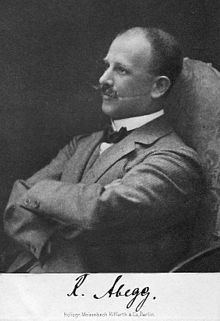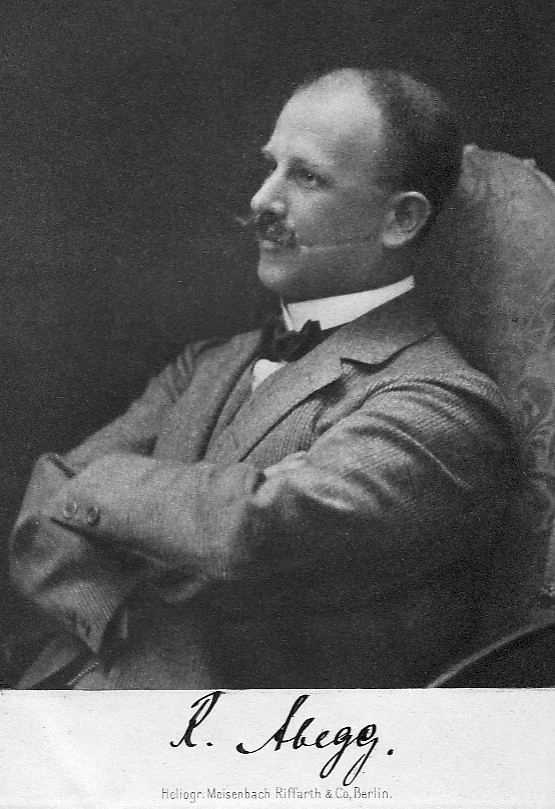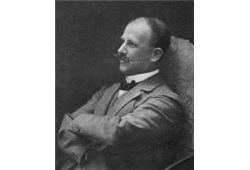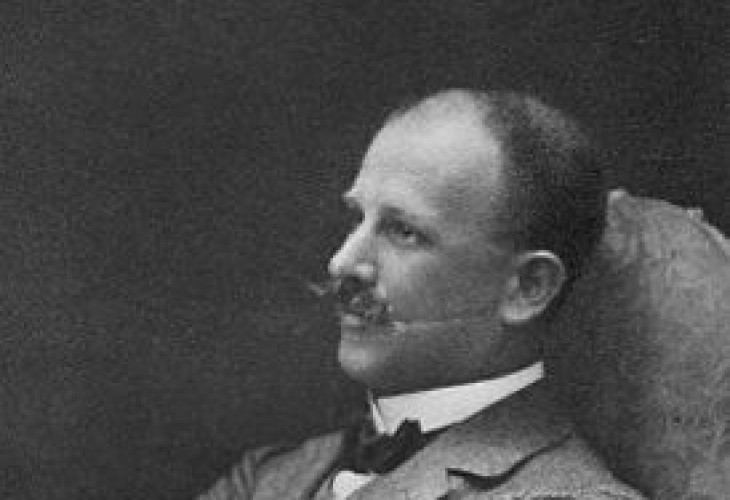Nationality German Residence Germany | Fields Chemist Name Richard Abegg | |
 | ||
Institutions University of GottingenUniversity of StockholmWroclaw University of Technology Books The electrolytic dissociation theory Education University of Tubingen, University of Kiel, Humboldt University of Berlin Similar People Clara Immerwahr, Walther Nernst, August Wilhelm von Hofm, Friedrich Bergius, Carl Bosch | ||
Doctoral students Clara Immerwahr | ||
Richard Wilhelm Heinrich Abegg (January 9, 1869 – April 3, 1910) was a German chemist and pioneer of valence theory. He proposed that the difference of the maximum positive and negative valence of an element tends to be eight. This has come to be known as Abegg's rule. He was a gas balloon enthusiast, which caused his death at the age of 41 when he crashed in his balloon in Silesia.
Contents

Abegg received his PhD on July 19, 1891 as the student of August Wilhelm von Hofmann at the University of Berlin. Abegg learned organic chemistry from Hofmann, but one year after finishing his PhD degree he began researching physical chemistry while studying with Friedrich Wilhelm Ostwald in Leipzig, Germany. Abegg later served as private assistant to Walther Nernst at the University of Göttingen and to Svante Arrhenius at the University of Stockholm.

Abegg discovered the theory of freezing-point depression and anticipated Gilbert Newton Lewis's octet rule by revealing that the lowest and highest oxidation states of elements often differ by eight. He researched many topics in physical chemistry, including freezing points, the dielectric constant of ice, osmotic pressures, oxidation potentials, and complex ions.

Personal life and education

Richard Abegg was the son of Wilhelm Abegg and Margarete Friedenthal. He had a brother, Wilhelm Abegg, who became the Prussian Secretary of State. After attending Wilhelm High School in Berlin, Abegg studied organic chemistry at the University of Kiel and the University of Tübingen. He then attended the University of Berlin, from which he received his doctorate as the student of August Wilhelm von Hofmann. In 1895, he married Line Simon, who became also a ballooning enthusiast.
Abegg occupied himself with photography and balloon excursions. He was the initiator and chairperson of the Silesian Club for Aeronautics in Breslau. Furthermore, he had an assessor's function with the presidency of the German Air Sailors' Association.
Work
During school, Abegg fulfilled his duties in the military. In 1891, he became an officer of the German Reserves. In 1900, he became an Oberleutnant in the Reserves in the 9th Regiment of Hussars. During this year, he made his first flight in a balloon, for military purposes. Balloon flights became a frequent pastime of both Abegg and his wife. He made many scientific observations during his subsequent flights, which were never published.
In 1894, Abegg worked as an assistant to Walther Nernst, one of the founders of physical chemistry and, at the time, Professor of Physical Chemistry. In 1897, he took a position as a professor of chemistry at the University of Breslau. Two years later, Abegg became a Privatdozent (chemistry chair) at the Wrocław University of Technology in Wrocław, Poland. A year later he became a professor. Clara Immerwahr, the first wife of Fritz Haber, studied and graduated as his student. In 1909 he became a full professor. Together with his colleague Guido Bodländer, he published on electro-affinity, then a new principle of inorganic chemistry.
Abegg is known best for his research recognizing the role that valence had with respect to chemical interactions. He found that some elements were less likely to combine into molecules, and from this concluded that the more stable elements had what are now called full electron shells. He was able to explain the attraction of atoms through opposite electrical charges. He also made the distinction between normal valence and contravalence. He found that the sum of these two valences always comes to eight, a rule that is now known as Abegg's rule.
Abegg was the editor of Zeitschrift fur Elektrochernie from 1901 until his death in 1910.
